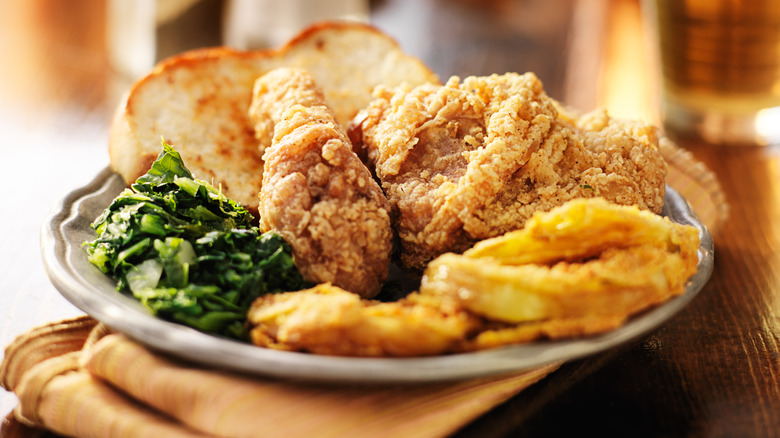What Is Soul Food Exactly?
"Soul food," a term first popularized in the 1960s, tends to conjure images of dinner plates heaped with hearty, home-cooked foods like fried chicken, greens, macaroni and cheese, and cornbread. At its essence, soul food — like its cousin, Southern food — was born from the need to make much culinary ado with very little. Impoverished communities throughout the rural South, both African American and white, have long relied on these filling and frugal foods to feed their families. Some of these foods were tragically introduced to the United States through the slave trade, with enslaved Africans bringing familiar crops — such as yams, black-eyed peas, okra, and collard greens — to the Americas, where they began creating new variations on old recipes.
When large numbers of African Americans began their Southern exodus during The Great Migration, they brought their beloved culinary traditions with them, which became known as soul food. As the Civil Rights and Black Power movements gained traction in the 1960s, African Americans openly celebrated their unique contributions to the American cultural landscape. In 1962, Sylvia Woods (the "Queen of Soul Food") opened the now-famous Sylvia's Restaurant in Harlem, marking the introduction of soul food to the Big Apple.
Soul food versus Southern food
Ultimately, there isn't much difference to the untrained palate between soul food and Southern food, but as a general rule, soul food tends to be spicier and saltier; this cuisine also promotes less food waste by using nearly every part of the animal. For poor communities in the South, animal fats like lard were a thrifty replacement for dairy-based butter and store-bought oil. Both cuisines don't shy away from small game animals or organ meats (think fried chicken livers), and both rely heavily on pork as a farm-raised meat source — especially smoked pork shoulder served with barbecue sauce.
Economical and nourishing vegetables like peas, beans, sweet potatoes, and greens keep bellies full, while corn is eaten straight from the cob, creamed, or ground into a fine meal perfect for coating fried fish or making fresh cornbread in a cast-iron skillet. Other favorite soul food sides and desserts include biscuits, hominy, fried okra, candied yams, banana pudding, and peach cobbler.
While soul food has a reputation for being high in saturated fat, sodium, and sugar, many of the ingredients used in soul food are actually nutritional powerhouses. Okra, sweet potatoes, and collard greens are packed with fiber, vitamins, and minerals, while organ meats are rich in B12, folate, iron, and protein. These nutrients make soul food so satisfying and hearty; making a few simple ingredient swaps can make this cuisine accessible to more restrictive diets.


